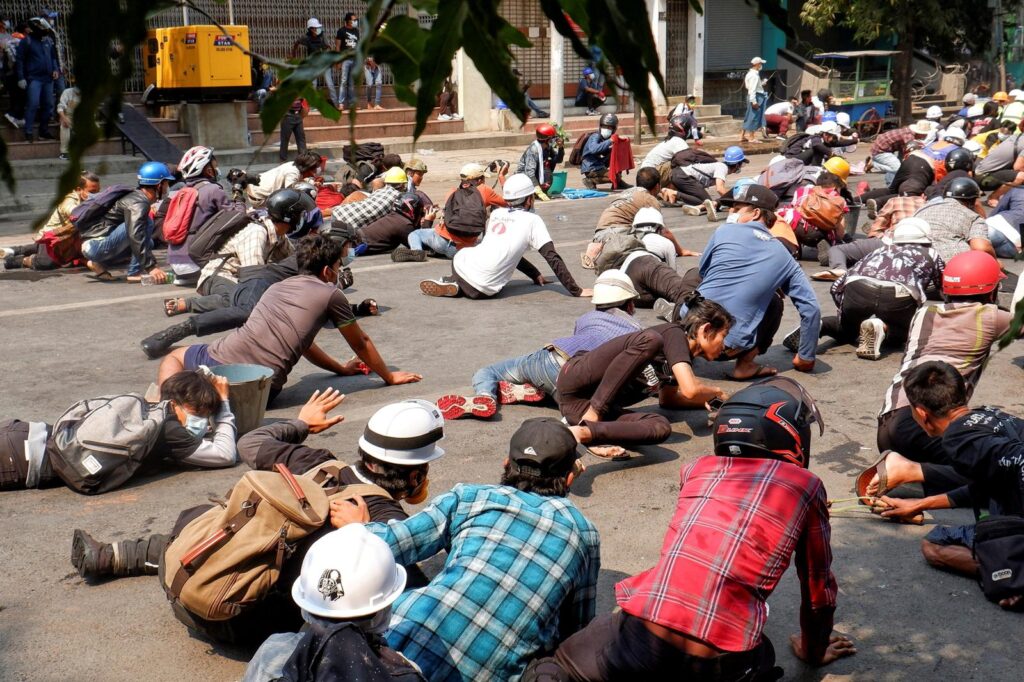Myanmar’s Young Pro-Democracy Activists Fill Up Prisons
Jun 14, 2023 | Pratirodh Bureau
Protesters lie on the ground after police open fire to disperse an anti-coup protest in Mandalay, Myanmar (Representational Image)
Police in Myanmar’s largest city, Yangon, came for Min Thwe Thit before dawn on February 1, 2021. He didn’t know why they had come — or what was unfolding in the Southeast Asian nation.
Min Thwe Thit has worked in pro-democracy movements since he was 17, eventually becoming a leader in the All Burma Federation of Student Unions.
Now he’s 40 years old and wears a T-shirt emblazoned with an image of Che Guevara.
Speaking from a sparse safe house in neighboring Thailand, he recalled that day in 2021 during which his interrogators put a black bag over his head and kept him awake without water for days.
They had brought with them an extensive dossier of his activism, which had landed him two stints in prison.
Eventually he found out what had happened. On the day of his arrest, Myanmar’s military had overthrown the democratically elected government of Aung San Suu Kyi and seized power in a coup.
He was one of the first victims in a new era of brutal political repression.
A Look Inside Myanmar’s Notorious Insein Prison
Over the last two years, the junta has locked away, tortured and killed those suspected of challenging their rule.
In Myanmar, at least 13,000 political prisoners are currently behind bars, according to the UN.
Although observers say their conditions have never been worse, the repression is familiar to generations of Burmese dissidents.
At a small museum run by the Assistance Association for Political Prisoners in Mae Sot, Thailand, near the Myanmar border, a tour guide calling himself Kyaw Win stands inside a mock jail.
The two-by-two meter cell was made to resemble where he stayed, with three other inmates, for six years.
“Maximum one hour a day we are out of the cell,” said Kyaw Win. “So we have a lot of time to spend.”
His crime was making political posters as a chemistry student in 1992.
Languishing Behind Bars
In the sweltering cell there was just a bucket for a toilet. Their food was often a watery vegetable broth and whatever insects made it into the pot. Inmates are packed so tightly in cells, there is hardly room to sleep.
“They have said, ‘When you are alive, you have to get out of the prison through the main gate — the front gate. If you’re dead, your dead body will go through the back gate,'” Kyaw Win said.
Colonial British rulers built Insein Prison in the 19th century. Over the years, Myanmar’s military filled it with dissidents like Kyaw Win who — despite beatings — made it out through its front gate.
As you move clockwise around the modest museum, panels display the country’s history of uprisings and crackdowns.
It starts in 1962, after Myanmar’s first coup.
When students at Rangoon University protested, authorities bombed their school and killed hundreds.
There’s the 1974 student demonstrations and the well-known 1988 uprising. From 1996 and 1998, there are pictures of bloody streets and crumpled bodies. In 2007, Buddhist monks led the so-called Saffron revolution.
“At the time, we had a lack of resources to get the information about the monks and also the people who were arrested in that revolution,” Kyaw Win said. He thinks hundreds were detained.
Documenting Myanmar’s Uprising
The Assistance Association for Political Prisoners works to shed light on human rights abuses using sources still in the country.
“We have more cases of people who were tortured to death during the interrogation,” said Aung Myo Min, human rights minister for the National Unity Government (NUG), a shadow government set up by deposed parliamentarians and civil society groups to oppose the military junta.
Before the coup, the museum in Mae Sot had only one photo of a prisoner formally executed by the military. Now there are five. More will come.
There is now a wall in the museum dedicated to the current uprising replete with photos of burned villages and charred bodies.
“We knew we were fighting in this revolution not only for the future but also for the past,” said Neo, 32, a doctor who fled Myanmar after the coup.
“Seeing the history and reality of these conditions make us sympathize more for our comrades and make us more motivated for our cause. We must free them and we won’t let the junta go unpunished.”
There are hundreds of pictures of civilians killed by the military. The faces — nearly all young — have gazes fixed across the room at the museum’s first display, into the eyes of those university students killed in 1962.
“We protest peacefully against the military regime in every uprising. But they crack down brutally,” said Kyaw Win.
He’s given this tour many times. It was hard at first, reliving the worst period in his life. But he admits it has also helped him.
“It’s also a part of my healing process,” he said.
Min Thwe Thit, the student leader picked up on the day of the coup, is handling freedom in his own way. While in prison he promised his fellow inmates to help their families financially if he got out.
He did get out, completing a year-long sentence for what he calls a trumped-up charge. Now he raises money to send to inmate’s families — around 100 people per month.
He can’t give them much. But he hopes it’s enough to keep them afloat — until their loved ones are released or Myanmar is free.
(Source: DW)
